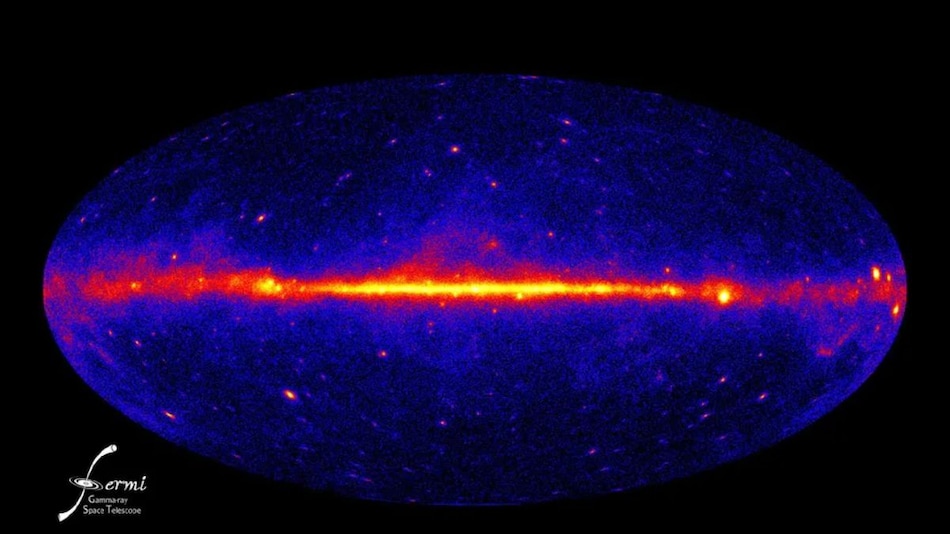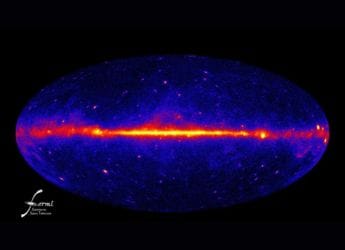- Home
- Science
- Science News
- Flattened Dark Matter May Explain Mysterious Gamma Ray Glow at Milky Way’s Core, Study Finds
Flattened Dark Matter May Explain Mysterious Gamma-Ray Glow at Milky Way’s Core, Study Finds
A new study suggests dark matter near the Milky Way’s center is flattened, possibly explaining its mysterious gamma-ray glow.

Photo Credit: NASA
Simulations show flattened dark matter matching Milky Way’s gamma-ray glow
For more than a decade, astronomers have been puzzled by the strange high-energy glow that blazes from the centre of the Milky Way, an excess of gamma rays that cannot be explained by known sources in its vicinity. Now, new computer simulations suggest that instead of being spherical, the dark matter around galaxies' centres may be “flattened,” potentially solving part of the mystery. The findings, described on 16 October in Physical Review Letters, suggest that this discoidal arrangement can create a radiation pattern matching what has been seen. This potentially revives a long-disputed theory linking dark matter to the Milky Way's bright central glow.
Flattened Dark Matter May Explain Mysterious Gamma-Ray Glow at Milky Way's Core
As per a report from the Leibniz Institute for Astrophysics Potsdam, the research was led by Moorits Mihkel Muru in collaboration with the University of Tartu in Estonia. The team used advanced HESTIA simulations to model how dark matter behaves under the influence of galactic forces. Their findings show that past mergers and gravitational interactions could distort dark matter into a flattened shape, closely matching the gamma-ray pattern captured by NASA's Fermi space telescope, which has long detected an unexplained excess of such energetic light.
A new study counters the idea that gamma rays from dark matter collisions are a result of millisecond pulsars. This suggests the geometry of dark matter could explain the unprecedented glow.
The researchers traced out that not all the dark matter around our galaxy is uniformly spherical; it could also be more dynamic. Due to the impact of galactic torques, such as those from the stellar spheroid in our galaxy.
Astronomers claim that the gamma-ray excess has been attributed to dark matter. So it needs to take more evidence from future observatories to trace out dark matter interactions and pulsars. This insight comes from the actual nature of dark matter.
For the latest tech news and reviews, follow Gadgets 360 on X, Facebook, WhatsApp, Threads and Google News. For the latest videos on gadgets and tech, subscribe to our YouTube channel. If you want to know everything about top influencers, follow our in-house Who'sThat360 on Instagram and YouTube.
Related Stories
- Samsung Galaxy Unpacked 2025
- ChatGPT
- Redmi Note 14 Pro+
- iPhone 16
- Apple Vision Pro
- Oneplus 12
- OnePlus Nord CE 3 Lite 5G
- iPhone 13
- Xiaomi 14 Pro
- Oppo Find N3
- Tecno Spark Go (2023)
- Realme V30
- Best Phones Under 25000
- Samsung Galaxy S24 Series
- Cryptocurrency
- iQoo 12
- Samsung Galaxy S24 Ultra
- Giottus
- Samsung Galaxy Z Flip 5
- Apple 'Scary Fast'
- Housefull 5
- GoPro Hero 12 Black Review
- Invincible Season 2
- JioGlass
- HD Ready TV
- Laptop Under 50000
- Smartwatch Under 10000
- Latest Mobile Phones
- Compare Phones
- OnePlus 15
- Redmi K90
- Redmi K90 Pro Max
- Nubia Z80 Ultra
- Realme GT 8
- Realme GT 8 Pro
- iQOO 15
- Red Magic 11 Pro
- MacBook Pro 14-inch (M5, 2025)
- Asus Vivobook S16 (S3607QA)
- iQOO Pad 5e
- OPPO Pad 5
- Garmin Venu X1
- Redmi Watch 6
- Xiaomi TV S Pro Mini LED 2026 (98-Inch)
- Xiaomi Xiaomi TV S Pro Mini LED 55 2026
- Asus ROG Ally
- Nintendo Switch Lite
- Haier 1.6 Ton 5 Star Inverter Split AC (HSU19G-MZAID5BN-INV)
- Haier 1.6 Ton 5 Star Inverter Split AC (HSU19G-MZAIM5BN-INV)

















